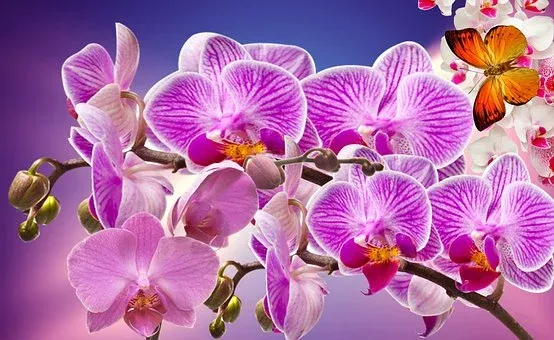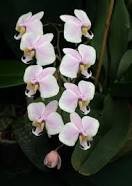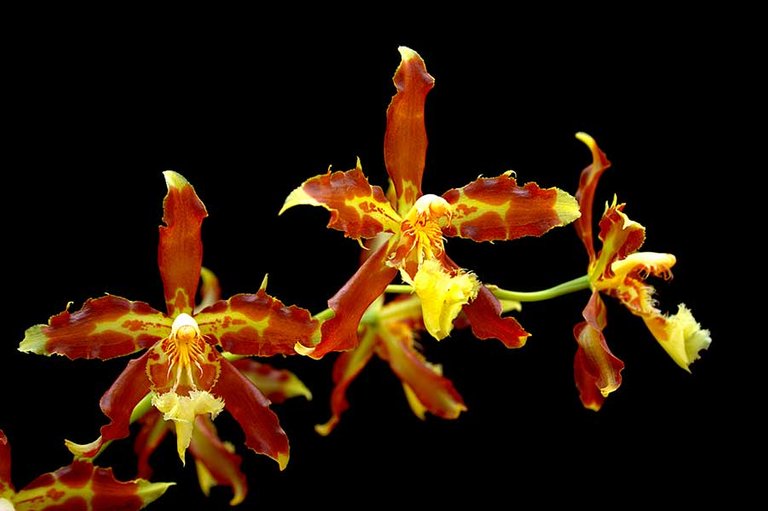LAS ORQUÍDEAS Y SU CONSERVACIÓN
LAS ORQUÍDEAS
Y SU CONSERVACIÓN

ORQUÍDEAS ( Familia Orchidaceae )
Las orquídeas son plantas que se encuentran bajo diferentes formas de crecimiento: trepadoras, epífitas, terrestres y raras veces subacuáticas o subterráneas. En nuestros bosques son muy comunes las epífitas, a las cuales el árbol portador le ofrece los mas diversos microambientes, como canalitos de agua, cojines de humus y sitios para sujetarse.
Los pseudobulbos y las raíces aéreas de las orquídeas almacenan agua; otras raíces le sirven a la orquídea para sujetarse del árbol.
En el mundo hay unas 35.000 especies y en Venezuela alrededor de 1.600.
Géneros de Orquídeas mas conocidas en Venezuela
Cattleya:
La mas conocida en Venezuela es la Flor de Mayo, Cattleya mossiae, Flor Nacional

Phalaenopsis

Dendrobium
¡Miren esta belleza!

Paphiopedilum

Vanda

Epidendrum

Oncidium

Odontoglossum
Y ésta Odontoglossum ¿ Les gusta ?

Uso y Conservación de la Orquídeas
La orquídea es una planta que atrae tanto a los nativos como a los visitantes por la particular belleza de sus flores. Sin embargo, la extracción de la misma de su hábitat natural, el bosque, ha traído como consecuencia la extinción y disminución de la población de muchas orquídeas. Es por ello que a nivel internacional está prohibido el comercio de orquídeas nativas del bosque, de acuerdo con el Convenio sobre Comercio Internacional de Especies Amenazadas (CITES) acordado en el año 1976.
Hoy en día el hombre produce las orquídeas en viveros y cada vez hay mas gente interesada en esta actividad. Esto puede contribuir a la perpetuación de las orquídeas, siempre que se conserven las reservas genéticas que se encuentran en el medio natural. El comercio de orquídeas obtenidas en viveros está permitido, con controles que buscan la protección de las especies nativas.
A nivel nacional está prohibida la extracción de especies nativas y cuando se permite con fines científicos, requiere de un permiso o acuerdo con la Oficina Nacional de Diversidad Biológica del Ministerio del Ambiente y de los Recursos Naturales.
Una práctica nefasta para una especie muy particular que engalana la selva nublada “el Helecho Arbóreo” es el cultivo de las orquídeas y otros tipos de plantas en raíces aéreas de este árbol, que se encuentra en nuestro país sólo en la montaña andina, contribuyendo a la destrucción de dicha especie. Esta práctica no se justifica pues existen otros medios donde la orquídea crece en forma exitosa, como son la fibra de concha de coco, el carbón vegetal, el anime o la corteza de pino hervida.

Una forma práctica de proteger las orquídeas nativas y sus genes es rescatar aquellas que se encuentren sobre árboles caídos y colocarlas dentro del bosque o criarlas cerca de donde fueron recogidas, en condiciones parecidas a las del bosque.
Por otra parte, la orquídea puede reproducirse mediante divisiones vegetativas como los retoños y los pseudobulbos o a partir de sus semillas y no es necesario tomar toda la planta, sino dejarla en su sitio natural para preservar sus genes. Es necesario que existan plantas grandes en el bosque para perpetuar la población silvestre.
Nunca deben comercializarse las orquídeas nativas, sino las que haya cultivado con el permiso de los organismos encargados de su protección.
Bibliografía:
- Hágsater E. Stewart J. “Estrategias para la Conservación de Orquídeas”. En: Orquideophilo, vol 7 N° 1, Marzo 1999
- Vareschi Volkmar. Ecología de la Vegetación Tropical. Sociedad Venezolana de Ciencias Naturales - CORPOVEN. Caracas. 1992
- Verdecchia A, Lugo C. “Para Cultivar Orquídeas”. Instituto Pedagógico de Caracas. 1999
Imágenes:
(Dendrobium sonia)
(https://orquideasdevenezuela.com/producto/dendrobium-sonia/)
[Flor de Mayo, Cattleya mossiae]
(https://www.google.com/search?client=firefox-b-d&q=cattleya+mossiae)
[Phalaenopsis]
(https://www.google.com/search?client=firefox-b-d&q=Phalaenopsis)
[Dendrobium]
(https://www.google.com/search?client=firefox-b-d&q=dendrobium+sonia)
[Paphiopedilum]
(https://www.google.com/search?client=firefox-b-d&q=+Paphiopedilum)
[Vanda]
(https://www.google.com/search?client=firefox-b-d&q=+Vanda)
[Epidendrum]
(https://orquidea.blogia.com/2005/021601-g-nero-epidendrum.php)
[Oncidium]
(https://www.google.com/search?client=firefox-b-d&q=Oncidium)
[Odontoglossum]
(https://www.cao.org.es/odontoglossum/)
[Cultivo de Orquídeas]
(https://www.google.com/search?client=firefox-b-d&q=+cultivo+de+orquideas+imagenes)
Englsh
ORCHIDS AND THEIR CONSERVATION

ORCHIDS ( Family Orchidaceae ) Orchids are plants that are found under different forms of growth: climbing, epiphytic, terrestrial and rarely underwater or underground. In our forests the epiphytes are very common, to which the carrier tree offers the most diverse microenvironments, such as water channels, humus cushions and places to hold on to. The pseudobulbs and aerial roots of orchids store water; other roots serve the orchid to hold on to the tree. In the world there are about 35,000 species and in Venezuela there are about 1,600.
Most Known Orchid Genera in Venezuela.
Cattleya: The most known in Venezuela is the Flor de Mayo, Cattleya mossiae, National Flower 

Phalaenopsis

Dendrobium Check out this beauty!

Paphiopedilum

Vanda

Epidendrum

Oncidium

Odontoglossum
And this one Odontoglossum Do you like it ?

Orchid Use and Conservation*.
The orchid is a plant that attracts both natives and visitors because of the particular beauty of its flowers. However, the extraction of the orchid from its natural habitat, the forest, has brought as a consequence the extinction and decrease of the population of many orchids. That is why at an international level the trade of native orchids from the forest is forbidden, according to the Convention on International Trade in Endangered Species (CITES) agreed in 1976. Nowadays man produces orchids in nurseries and more and more people are interested in this activity. This can contribute to the perpetuation of orchids, provided that the genetic reserves found in the wild are preserved. The trade of orchids obtained in nurseries is permitted, with controls that seek to protect native species. At the national level, the extraction of native species is prohibited and when it is permitted for scientific purposes, it requires a permit or agreement with the National Office of Biological Diversity of the Ministry of the Environment and Natural Resources.
A harmful practice for a very particular species that graces the cloud forest "the Tree Fern" is the cultivation of orchids and other types of plants in aerial roots of this tree, which is found in our country only in the Andean mountains, contributing to the destruction of this species. This practice is not justified because there are other means where the orchid grows successfully, such as coconut shell fiber, charcoal, anime or boiled pine bark. 
A practical way to protect native orchids and their genes is to rescue those found on fallen trees and place them inside the forest or raise them near where they were collected, in forest-like conditions. On the other hand, the orchid can reproduce by vegetative divisions such as shoots and pseudobulbs or from their seeds and it is not necessary to take the whole plant, but leave it in its natural site to preserve its genes. It is necessary to have large plants in the forest to perpetuate the wild population. Native orchids should never be traded, only those that have been cultivated with the permission of the agencies in charge of their protection.
Bibliography: - Hágsater E. Stewart J. "Strategies for Orchid Conservation". In: Orquideophilo, vol 7 N° 1, March 1999 - Vareschi Volkmar. Ecology of Tropical Vegetation. Venezuelan Society of Natural Sciences - CORPOVEN. Caracas. 1992 - Verdecchia A, Lugo C. "Para Cultivar Orquídeas". Pedagogical Institute of Caracas. 1999
Images:
(Dendrobium sonia) (https://orquideasdevenezuela.com/producto/dendrobium-sonia/)
[Flor de Mayo, Cattleya mossiae]
(https://www.google.com/search?client=firefox-b-d&q=cattleya+mossiae)
[Phalaenopsis]
(https://www.google.com/search?client=firefox-b-d&q=Phalaenopsis)
[Dendrobium]
(https://www.google.com/search?client=firefox-b-d&q=dendrobium+sonia)
[Paphiopedilum]
(https://www.google.com/search?client=firefox-b-d&q=+Paphiopedilum)
[Vanda]
(https://www.google.com/search?client=firefox-b-d&q=+Vanda)
[Epidendrum]
(https://orquidea.blogia.com/2005/021601-g-nero-epidendrum.php)
[Oncidium]
(https://www.google.com/search?client=firefox-b-d&q=Oncidium)
[Odontoglossum]
(https://www.cao.org.es/odontoglossum/)
[Cultivo de Orquídeas]
(https://www.google.com/search?client=firefox-b-d&q=+cultivo+de+orquideas+imagenes)
Que hermosas son las orquideas y conocerlas a fondo es mejor saludos!
Hermosas plantas, su color es espectacular.
I appreciate your work and your post has been manually curated by Botanic team @oscurity on behalf of Amazing Nature Community. Keep up the good work!
fantastic post
We appreciate your work and your post was manually curated by @none! from the DNA team!
Reach us on Discord to learn more about the project!